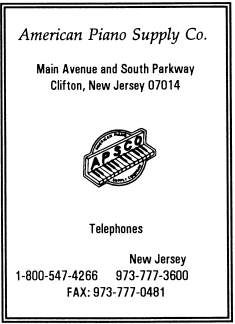 Our technical was by Kent Webb of Steinway. He talked about damper regulation and troubleshooting. He showed us slides of the tools needed to work on dampers - parallel pliers, bending and regulating pliers. Kent said that dampers are difficult to work on because there is no standard for efficiency. They are also difficult to access. Many noises caused by dampers will be noticed by customers more than most other sounds. In regulating dampers we should adjust the timing and performance, he said. He also said it is important to communicate with the customer when we work on them. We can soften dampers with denatured alcohol or methanol. Some problems with dampers are overtones due to improper string placement or improper damper placement. We may also hear a "whoosh" sound due to excess felt on the damper. Kent said we should also lubricate the pedals with cork grease or Lubriplate, and put talc on the keybed. Our meeting ended at 9:45. We thank Kent for his excellent presentation and wish him luck in his new position at Steinway. |
A school recently called me to tune and repair a few "dead notes" on a spinet for a program they were presenting that week. I expected to find the usual broken elbows or hammer shanks, but instead encountered a Depression-era Hardman Minipiano with several missing abstracts. These abstracts, which rest horizontally above the keystick and accept a lifter wire, are unique to the instrument's drop-action design and replacement parts are unavailable. The private school's budget was rather limited and I did not have the time nor desire to hand-fabricate new parts in the shop in time for the concert. So I had to improvise a repair on the spot with the parts I had on hand. The following solution proved to be not only simple and quick, but efficient and economical as well. 1. Since original parts are always preferable, I "cannibalized" some abstracts from the little-played notes at the extremes of the keyboard, and installed them in the heavily used tenor section. 2. I then took some full-size upright jacks (which are nearly identical in length and width to the Minipiano abstracts) and removed the normal jack flanges, installing standard Pratt-Read flanges in their place. Orient the jack horizontally with the tender pointing upward, the flange downward with the routed channel facing the top of the jack. 3. Mount the new jack and flange configuration to the action rail as a substitute abstract. (Note: Although it is not necessary, you may wish to cut off the jack tender for aesthetic reasons. Do so before mounting the jack to the action rail). |